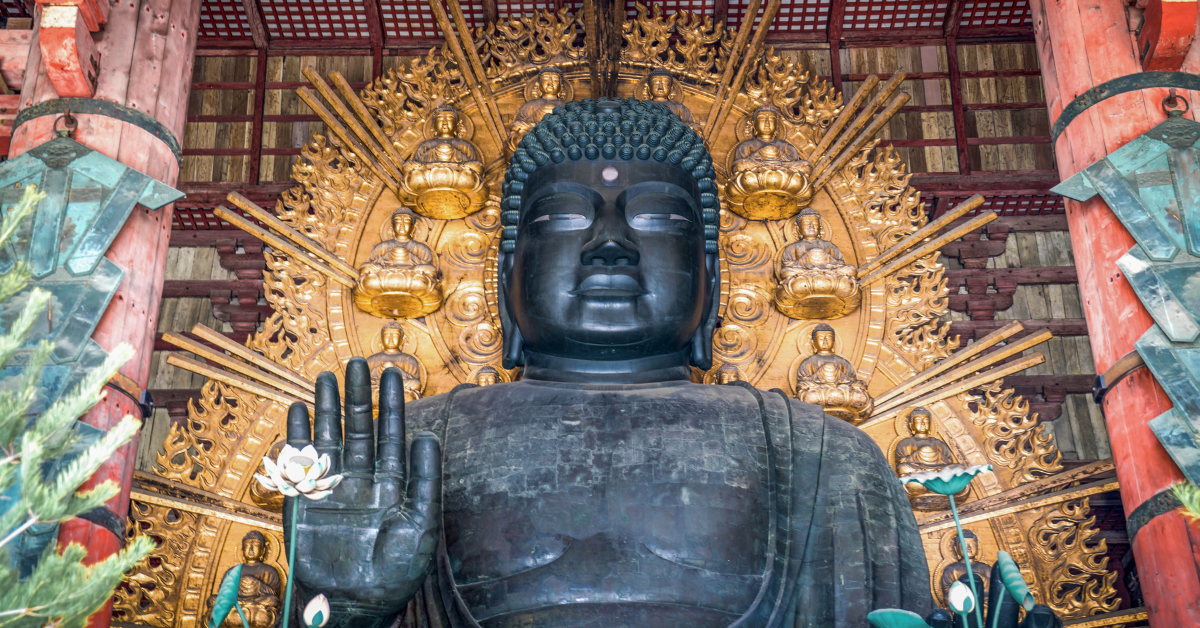Located in Nara, Tōdai-ji is one of Japan’s most iconic temples, known for its majestic Great Buddha and peaceful coexistence with wild deer. As a UNESCO World Heritage Site, it offers a rare opportunity to experience both ancient spirituality and vibrant nature in one place.
Overview and Historical Background of Tōdai-ji
Tōdai-ji was established in the 8th century during the Nara period by Emperor Shōmu. At that time, Japan was suffering from widespread plagues and disasters. The emperor hoped to stabilize the nation through the power of Buddhism. The temple’s main building, the Great Buddha Hall, embodies the prayers and craftsmanship of the people of that era.
Over the centuries, the temple has been damaged by fires and earthquakes but was restored repeatedly. In 1998, it was registered as part of the “Historic Monuments of Ancient Nara” on the UNESCO World Heritage List, highlighting its international cultural significance. Within the grounds, you’ll find other historical structures like the Kaidan-dō and Nigatsu-dō, making it a place not only for religious practice but also for cultural immersion.
The Striking Presence of the Great Buddha of Nara
The Great Buddha of Nara (Rushanabutsu), enshrined inside the Daibutsuden (Great Buddha Hall), leaves a powerful impression on all visitors. Standing at 15 meters tall and weighing over 500 tons, this giant bronze statue is more than just a tourist attraction — it tells the story of Japanese Buddhism and architectural history.
The expression, posture, and balance of the statue reflect remarkable craftsmanship and deep religious devotion. Standing before it, one cannot help but feel a sense of awe and tranquility.
| Item | Description |
|---|---|
| Name | Rushanabutsu (Vairocana Buddha) |
| Height | Approximately 15 meters |
| Material | Bronze |
| Weight | Over 500 tons |
| Year of Construction | 752 (Nara period) |
Observing the Buddha closely reveals meticulous details, such as the carving of the eyes and hands, and the floral design of the pedestal. It is a must-see for anyone interested in art, spirituality, or history.
Enjoying Nara Park and Interacting with Sacred Deer
Next to Tōdai-ji lies Nara Park, where about 1,200 deer roam freely. These deer are regarded as “messengers of the gods” and are protected as part of the region’s spiritual heritage. Visitors can buy special “deer crackers” and feed them directly, which has become a highlight for many foreign tourists.
The deer are very accustomed to humans and may even appear to bow before receiving food. This behavior is not trained but learned over generations of interaction with visitors.
| Tips for Interacting with Deer | Advice |
|---|---|
| Feeding posture | Approach calmly and show your palm with food |
| Avoid sudden movements | Startled deer may react unpredictably |
| Do not touch fawns | Mother deer may become defensive |
| Watch your bags | Deer may mistake them for food |
Interacting with the deer offers more than just entertainment — it provides a cultural insight into the Japanese respect for nature and harmony with animals.
Essential Travel Information Before You Visit
To enjoy your visit fully, it’s helpful to gather some practical information beforehand. This is especially important for foreign travelers who may be unfamiliar with local transportation or language barriers.
| Item | Details |
|---|---|
| Opening Hours | 7:30 AM to 5:30 PM (varies by season) |
| Admission | 600 yen for adults, 300 yen for children |
| Access | 20-minute walk or 5-minute bus ride from Kintetsu Nara Station |
| Language Support | Signs available in English, Chinese, and Korean |
| Best Visiting Time | Morning hours on weekdays are less crowded |
Several rest areas and souvenir shops are located near the entrance. Visitors are advised to be mindful of quiet zones and areas where photography is prohibited inside temple buildings.
Explore More Attractions Around Tōdai-ji
The Tōdai-ji area is surrounded by other must-see attractions, all within walking distance. It’s easy to plan a full day exploring the region without needing public transport.
| Attraction | Highlights |
|---|---|
| Kasuga Taisha Shrine | Bright red shrine buildings set in sacred forest |
| Kōfuku-ji Temple | Home to the famous Ashura statue, a national treasure |
| Nara National Museum | Exhibits focusing on Buddhist art and historical artifacts |
| Naramachi | Old town area with preserved merchant houses and crafts shops |
Naramachi, in particular, is ideal for experiencing traditional Japanese townscapes and trying local sweets or crafts.
Best Seasons and Events to Visit Tōdai-ji
Tōdai-ji offers a different atmosphere in each season. Visiting during the right time of year can significantly enhance your experience.
| Season | Highlights |
|---|---|
| Spring (March–April) | Cherry blossoms in full bloom |
| Summer (June–August) | Shaded paths and cool retreats with deer |
| Autumn (October–November) | Stunning fall colors throughout the grounds |
| Winter (December–February) | Snowy tranquility and fewer tourists |
One major event is the Shuni-e (Omizutori) in March. This fire ceremony, held at Nigatsu-dō, features massive torches and is a breathtaking spiritual experience unlike any other in Japan.
Conclusion
Tōdai-ji is not just a historical site — it’s a place where visitors can experience Japanese faith, craftsmanship, harmony with nature, and seasonal beauty all in one location. Whether it’s standing before the Great Buddha, feeding deer in the park, or strolling through a forested path, every moment brings you closer to understanding Japan’s unique cultural heart.
When planning your visit to Japan, be sure to include Tōdai-ji as a highlight of your trip. It promises not just sightseeing, but a deep and lasting cultural experience you won’t forget.






